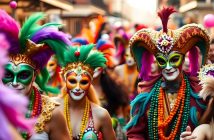A rhinoceros is not something you’d associate with Champagne. The odd-toed ungulate and northeastern French wine region seemingly have very little in common, and yet in the space of three days, I had two encounters with the African animal – the first housed within an imposing painting hung above the bed on my hotel room wall, and the second in the form of a gargoyle jutting out from the Notre-Dame de Reims cathedral. A symbol of fertility and courage, the rhino’s presence on the façade is thought to imbue kings in worship with physical and mental strength.
My journey to the land of bubbles begins in a civilised manner on a Sunday morning with a slender flute of ice-cold Gosset and a platter of aphrodisiacal oysters, so fresh you could clean your contacts in them, at the St Pancras Grand Champagne Bar in King’s Cross – the longest bar in Europe. Joined by fellow Champagne socialites Douglas Blyde and Denise Medrano, affectionately known as The Wine Sleuth, our fizz lesson continues in earnest aboard the Eurostar – in a carriage populated with beshrouded women festooned with bangles, with shot glasses of Champagne Pannier.
Ninety miles northeast of Paris, Champagne is France’s most northerly appellation. Curiously, the predominantly white sparkling wine is made from two black grapes – Pinot Noir and Pinot Meunier (a relative of Pinot Noir), and one white: Chardonnay. Each of the grapes brings something different to the sorting table – the Pinot Noir backbone, the Pinot Meunier fruit and the Chardonnay freshness, leading to a complex and attractive final blend. Champagne can also be made solely with Chardonnay (Blanc de Blancs) or the two black grapes (Blanc de Noirs). All sparkling wine starts life still. With Champagne, the fizz occurs in the bottle when a secondary fermentation takes place after sugar and yeast are added. The yeasts devour the sugar, converting it into alcohol and carbon dioxide.
A word bandied about daily in the wine press is ‘terroir’, loosely translated as ‘a sense of place’, and used to describe the special characteristics that the geography, geology and climate of a region bestow upon its grape varieties. Champagne’s terrain is made up of deep layers of chalk, which often translates into the wines in the form of a steely mineral core. Of its 319 villages, a mere 17 have been designated as ‘Grand Cru’ sites, which include Bouzy, Äy and Le Mesnil. Like Sherry, Champagne runs the gamut of styles from bone dry Zero Dosage to Doux, a sweet dessert wine.
But enough with the science. Our first pit stop is with small grower Champagne Henriet-Bazin in Villers-Marmery. We enter a domestic space populated with painted landscapes, a twig-filled fireplace and a giant urn in the far corner. A comforting smell of home cooking saunters through the kitchen door. Proprietor Nicolas Rainon’s wife is passionate about daring food pairings for Champagne, and seems keen to try out her latest discoveries on us, beginning with salt marsh lamb paté and Blanc de Blancs Brut, which works surprisingly well – the saltiness of the lamb complementing the saline mineral notes in the wine. The most ambitious match of the meal was the attempt to pit their Blanc de Noirs against the might of Boeuf Bourguignon, which was always doomed to fail, but the grainy pear tart and Rosé Brut combination is inspired.
Post feast, I’m licked hello by tiny winery dog Estéphe, named after the Left Bank Bordeaux commune. As proud as the Champenois are, I’m surprised he hasn’t been crowned with a name like Epernay. Nicolas ushers us into his scuffed 4×4, navigating the narrow streets into a forest where only he dares drive. After a perilous few minutes, we reach a clearing and are within touching distance of the vines. Shafts of afternoon light beam on the leaves, making them glow a vibrant green. After careering down a hill capable of totalling both us and the car, we pass a glass-fronted lighthouse and the iconic Mumm windmill, which plays host to A-list private parties.
Before death becomes us, we move swiftly on to Champagne Ployez-Jacquemart in the sleepy village of Ludes, where we’re greeted by gregarious proprietor Madame Laurence Ployez, resplendent in red. Bought in 1930 by her grandfather, the estate boasts an adorable B&B pregnant with flowers, which housed British soldiers during the Second World War, and safeguarded German soldiers after. A ‘Kill Hitler’ scribbling written by a British soldier in 1939 is still visible in one of the rooms. When German soldiers besieged Ludes, the Ployez family fled to Pompadour in Southern France, building a wall between their two cellars before they left, in which to hide their belongings from looters.
After a tour of the cavernous cellars straight from the pages of an Edgar Allan Poe short story, we sit out on the terrace, glass in hand, sun dipping deep, and indulge in Madame’s exquisite pastries while furry-footed chickens roam the well manicured lawn. The pair of Prestige Cuvées we try – 1996 and 1998 Liesse d’Harbonville – are an exciting discovery. Elegant, poised and textured, they could hold their own against any of the Grandes Marques.
Capping off our adventure, we pay a visit to Champagne Jacquesson the next morning, run by brothers Jean-Hervé and Laurent Chiquet. With a production of 300,000 bottles a year, Jacquesson bridges the gap between Grande Marque and grower Champagne. A hybrid of Vito Corleone and Jean-Paul Belmondo, the charismatic and outspoken Jean-Hervé gives us a tour, proudly showing us his Chardonnay grapes being crushed to a soundtrack of Simon & Garfunkel.
A coach cruises past the estate filled with raucous rogues tooting foghorns and screaming with glee. I presume a stag party has lost its way. “They’re our pickers,” says Chiquet. “They’ve just finished and are celebrating the end of the harvest.” Chiquet is audacious in his winemaking approach, shunning the idea of a house style in favour of producing the best wine he can each year from the grapes he’s grown. “There’s no point trying to imitate the big guys; I want to stand out from the crowd.”
Before hopping back on the Eurostar, we make a pilgrimage to the breathtakingly beautiful 13th century Notre-Dame de Reims cathedral. Inside, the interiors burn with jewel-like hues from a sea of stained glass. In one window, I spot Benedictine monk Dom Pérignon (after which the famous fizz is named) indulging in a spot of riddling, and in another, soaring saints by French painter Marc Chagall, but sadly, not a violin-playing goat in sight.




